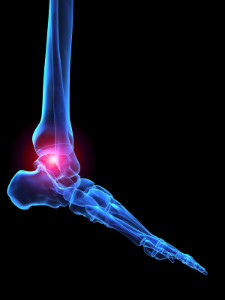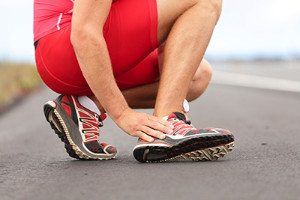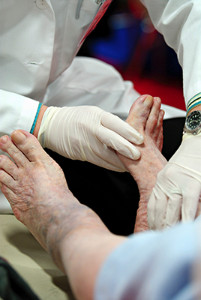
Drexel Hill (484) 521-0233
West Chester (610) 436-5883

Drexel Hill (484) 521-0233
West Chester (610) 436-5883
 When the tissue around the nerve leading to the toes becomes thickened, it can cause a painful condition known as Morton's neuroma. It usually affects one side of the foot, as it typically occurs between the third and fourth toes. The symptoms can include a burning sensation, numbness, or tingling. Wearing high-heeled shoes can be a cause of Morton's neuroma. As a result of this, more women are affected by this condition than men. Another cause could be jogging and certain sports. This form of activity can put pressure on the ligament, which ultimately causes pain.
When the tissue around the nerve leading to the toes becomes thickened, it can cause a painful condition known as Morton's neuroma. It usually affects one side of the foot, as it typically occurs between the third and fourth toes. The symptoms can include a burning sensation, numbness, or tingling. Wearing high-heeled shoes can be a cause of Morton's neuroma. As a result of this, more women are affected by this condition than men. Another cause could be jogging and certain sports. This form of activity can put pressure on the ligament, which ultimately causes pain.
Morton’s neuroma is a very uncomfortable condition to live with. If you think you have Morton’s neuroma, contact the podiatrists of Dr. Siegerman & Associates. Our doctors will attend to all of your foot care needs and answer any of your related questions.
Morton’s Neuroma
Morton's neuroma is a painful foot condition that commonly affects the areas between the second and third or third and fourth toe, although other areas of the foot are also susceptible. Morton’s neuroma is caused by an inflamed nerve in the foot that is being squeezed and aggravated by surrounding bones.
What Increases the Chances of Having Morton’s Neuroma?
Morton’s neuroma is a very treatable condition. Orthotics and shoe inserts can often be used to alleviate the pain on the forefront of the feet. In more severe cases, corticosteroids can also be prescribed. In order to figure out the best treatment for your neuroma, it’s recommended to seek the care of a podiatrist who can diagnose your condition and provide different treatment options.
If you have any questions, please feel free to contact one of our offices located in Drexel Hill and West Chester, PA . We offer the newest diagnostic and treatment technologies for all your foot care needs.
 Rheumatoid arthritis is a disorder and form of arthritis in which the body’s immune system attacks the lining of the joints. This can cause pain and inflammation and over time can damage the joints and bone. Rheumatoid arthritis can occur in any joint in the body but often occurs in the hands, wrists, and feet. Symptoms include pain, stiffness, and inflammation. Other symptoms can include fatigue, numbness, fever, sweating, and weight loss. These symptoms can often come and go and can last for days or weeks. There is currently no cure for rheumatoid arthritis; however seeing a doctor, such as a podiatrist, if you are experiencing pain in your feet can help provide a diagnosis and treatment. Treatment options may include therapy, medication, and, in some cases, surgery.
Rheumatoid arthritis is a disorder and form of arthritis in which the body’s immune system attacks the lining of the joints. This can cause pain and inflammation and over time can damage the joints and bone. Rheumatoid arthritis can occur in any joint in the body but often occurs in the hands, wrists, and feet. Symptoms include pain, stiffness, and inflammation. Other symptoms can include fatigue, numbness, fever, sweating, and weight loss. These symptoms can often come and go and can last for days or weeks. There is currently no cure for rheumatoid arthritis; however seeing a doctor, such as a podiatrist, if you are experiencing pain in your feet can help provide a diagnosis and treatment. Treatment options may include therapy, medication, and, in some cases, surgery.
Because RA affects more than just your joints, including the joints in your feet and ankles, it is important to seek early diagnosis from your podiatrist if you feel like the pain in your feet might be caused by RA. For more information, contact the podiatrists of Dr. Siegerman & Associates. Our doctors will assist you with all of your podiatric concerns.
What Is Rheumatoid Arthritis?
Rheumatoid Arthritis (RA) is an autoimmune disorder in which the body’s own immune system attacks the membranes surrounding the joints. Inflammation of the lining and eventually the destruction of the joint’s cartilage and bone occur, causing severe pain and immobility.
Rheumatoid Arthritis of the Feet
Although RA usually attacks multiple bones and joints throughout the entire body, almost 90 percent of cases result in pain in the foot or ankle area.
Symptoms
Diagnosis
Quick diagnosis of RA in the feet is important so that the podiatrist can treat the area effectively. Your doctor will ask you about your medical history, occupation, and lifestyle to determine the origin of the condition. Rheumatoid Factor tests help to determine if someone is affected by the disease.
If you have any questions please feel free to contact one of our offices located in Drexel Hill and West Chester, PA . We offer the newest diagnostic and treatment technologies for all your foot and ankle needs.
 Athlete’s foot is a skin infection caused by fungus. As the name implies, it is common among athletes; this is mainly due to the fact that locker rooms, pools, and public showers are likely to harbor the fungus. The fungus also prefers moist, warm, and dark areas such as in between the toes on feet that are generally covered with shoes. While the infection usually first occurs between the toes, it can spread to the rest of the foot. Symptoms include redness, itchiness, burning sensations, and peeling skin. If scratched, the fungus can spread to other parts of the body like nails. To prevent athlete’s foot, keep your feet dry. If your feet sweat a lot, change socks frequently to prevent moisture buildup. Once you are finished showering or out of the pool, dry the feet thoroughly. Finally, wear shoes that allow the feet to "breathe” to help prevent sweat and allow the feet to cool down.
Athlete’s foot is a skin infection caused by fungus. As the name implies, it is common among athletes; this is mainly due to the fact that locker rooms, pools, and public showers are likely to harbor the fungus. The fungus also prefers moist, warm, and dark areas such as in between the toes on feet that are generally covered with shoes. While the infection usually first occurs between the toes, it can spread to the rest of the foot. Symptoms include redness, itchiness, burning sensations, and peeling skin. If scratched, the fungus can spread to other parts of the body like nails. To prevent athlete’s foot, keep your feet dry. If your feet sweat a lot, change socks frequently to prevent moisture buildup. Once you are finished showering or out of the pool, dry the feet thoroughly. Finally, wear shoes that allow the feet to "breathe” to help prevent sweat and allow the feet to cool down.
Athlete’s foot is an inconvenient condition that can be easily reduced with the proper treatment. If you have any concerns about your feet and ankles, contact the podiatrists from Dr. Siegerman & Associates. Our doctors will treat your foot and ankle needs.
Athlete’s Foot: The Sole Story
Athlete's foot, also known as tinea pedis, can be an extremely contagious foot infection. It is commonly contracted in public changing areas and bathrooms, dormitory style living quarters, around locker rooms and public swimming pools, or anywhere your feet often come into contact with other people.
Solutions to Combat Athlete’s Foot
Athlete’s foot can cause many irritating symptoms such as dry and flaking skin, itching, and redness. Some more severe symptoms can include bleeding and cracked skin, intense itching and burning, and even pain when walking. In the worst cases, Athlete’s foot can cause blistering as well. Speak to your podiatrist for a better understanding of the different causes of Athlete’s foot, as well as help in determining which treatment options are best for you.
If you have any questions please feel free to contact one of our offices located in Drexel Hill and West Chester, PA . We offer the newest diagnostic and treatment technologies for all your foot and ankle needs.
 Working out and building strength is a good way to help prevent running injuries. Here are a couple of workouts you can try to help build muscle in your feet and legs. Do each of these exercises for and 4 to 5 sets of 15 to 25 repetitions . Before you do these however, it is recommended you see a podiatrist first and ask if exercising is right for you. To do a toe-curl walk, stand barefoot and move forward with your right leg using only your toes, then do the same for the left foot; you will only move an inch or so while doing this. Heel raises are easy to do. Just stand up on your toes while keeping your heels off the ground for about 1 second and then come down. Chair squats are a good way to work your quadriceps. Place a non-rolling chair behind you, and squat down over it so that your butt only briefly touches the chair. Then come up. Finally, to workout your gluteus muscles, lay on your stomach and bend your knee at a 90 degree angle. Slowly raise your thigh off the ground for a couple of seconds, then bring down your thigh and repeat with the other leg. These exercises are quick and easy to do and will build strength that will further help prevent running injuries.
Working out and building strength is a good way to help prevent running injuries. Here are a couple of workouts you can try to help build muscle in your feet and legs. Do each of these exercises for and 4 to 5 sets of 15 to 25 repetitions . Before you do these however, it is recommended you see a podiatrist first and ask if exercising is right for you. To do a toe-curl walk, stand barefoot and move forward with your right leg using only your toes, then do the same for the left foot; you will only move an inch or so while doing this. Heel raises are easy to do. Just stand up on your toes while keeping your heels off the ground for about 1 second and then come down. Chair squats are a good way to work your quadriceps. Place a non-rolling chair behind you, and squat down over it so that your butt only briefly touches the chair. Then come up. Finally, to workout your gluteus muscles, lay on your stomach and bend your knee at a 90 degree angle. Slowly raise your thigh off the ground for a couple of seconds, then bring down your thigh and repeat with the other leg. These exercises are quick and easy to do and will build strength that will further help prevent running injuries.
Exercising your feet regularly with the proper foot wear is a great way to prevent injuries. If you have any concerns about your feet, contact the podiatrists of Dr. Siegerman & Associates. Our doctors will treat your foot and ankle needs.
How to Prevent Running Injuries
Many common running injuries are caused by overuse and overtraining. When the back of the kneecap starts wearing out and starts causing pain in your knee, this is commonly referred to as runner’s knee. Runner’s knee is a decrease in strength in your quadriceps and can occur if you’re not wearing properly fitted or supporting shoes. To prevent runner’s knee, focusing on hip strengthening is a good idea, as well as strengthening your quads to keep the kneecaps aligned.
What Are Some Causes of Running Injuries?
- One cause of a common running injury is called iliotibial band syndrome.
- Plantar fasciitis is also another common injury.
- Stress fractures can occur from overtraining, lack of calcium, or even your running style.
Best Ways to Prevent Running Injuries
- Wear footwear that fits properly and suits your running needs.
- Running shoes are the only protective gear that runners have to safeguard them from injury.
- Make a training schedule. Adding strengthening exercises as well as regular stretching can help keep you strong and limber and can lessen the possibility of injuries.
- Stretching keeps muscles limber; this will help you gain better flexibility.
If you have any questions please feel free to contact one of our offices located in Drexel Hill and West Chester, PA . We offer the newest diagnostic and treatment technologies for all your foot and ankle needs.
 Falls and their effects on the elderly are, unfortunately, not reported on enough. This lack of reporting prevents overall awareness and the spread of knowledge in how to prevent them. Fortunately this has been changing in the past several years, with 2008 marking the first year that Falls Prevention Awareness Day was held by the National Council on Aging (NCOA). Despite this, awareness of the issue has a long way to go. Here are some facts about falls and falls prevention. Those who are age 65 or older and who have been to the emergency department are unlikely to engage in falls-prevention programs once discharged. While it has been reported that regular strength and flexibility programs for the elderly help prevent falls, some practices like Tai Chi have been found to help as well. Finally, elderly persons who have a history of falls, have suffered from a previous fracture, and have a body mass index (BMI) of 20 kg/m² are more likely to suffer another fracture.
Falls and their effects on the elderly are, unfortunately, not reported on enough. This lack of reporting prevents overall awareness and the spread of knowledge in how to prevent them. Fortunately this has been changing in the past several years, with 2008 marking the first year that Falls Prevention Awareness Day was held by the National Council on Aging (NCOA). Despite this, awareness of the issue has a long way to go. Here are some facts about falls and falls prevention. Those who are age 65 or older and who have been to the emergency department are unlikely to engage in falls-prevention programs once discharged. While it has been reported that regular strength and flexibility programs for the elderly help prevent falls, some practices like Tai Chi have been found to help as well. Finally, elderly persons who have a history of falls, have suffered from a previous fracture, and have a body mass index (BMI) of 20 kg/m² are more likely to suffer another fracture.
Preventing falls among the elderly is very important. If you are older and have fallen or fear that you are prone to falling, consult with the podiatrists from Dr. Siegerman & Associates. Our doctors will assess your condition and provide you with quality advice and care.
Every 11 seconds, an elderly American is being treated in an emergency room for a fall related injury. Falls are the leading cause of head and hip injuries for those 65 and older. Due to decreases in strength, balance, senses, and lack of awareness, elderly persons are very susceptible to falling. Thankfully, there are a number of things older persons can do to prevent falls.
How to Prevent Falls
Some effective methods that older persons can do to prevent falls include:
Falling can be a traumatic and embarrassing experience for elderly persons; this can make them less willing to leave the house, and less willing to talk to someone about their fears of falling. Doing such things, however, will increase the likelihood of tripping or losing one’s balance. Knowing the causes of falling and how to prevent them is the best way to mitigate the risk of serious injury.
If you have any questions, please feel free to contact one of our offices located in Drexel Hill and West Chester, PA . We offer the newest diagnostic and treatment technologies for all your foot care needs.
Request a free copy of
Laser Away Foot Pain!
today.
